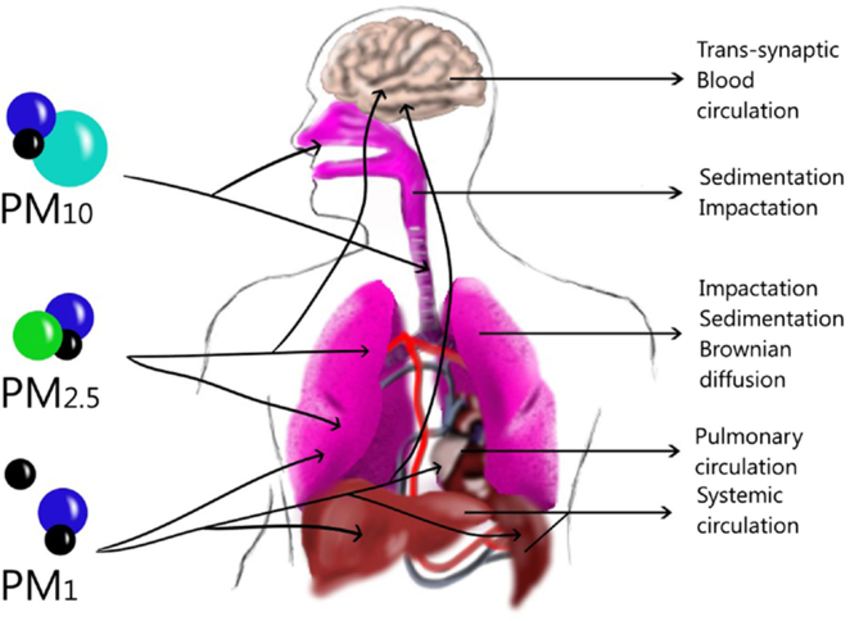Recent evidence indicates that air pollution can not only affect our respiratory and cardiovascular systems but can also exert adverse effects on human skin.

Air pollution is a contamination of either the indoor or outdoor environment by any chemical, physical, or biological agent.
Air pollution is currently considered the world’s most significant single environmental health risk factor. In 2013, the International Agency for Research on Cancer (IRAC) classified outdoor air pollution as carcinogenic to humans.
Air pollution is mainly composed of: particulate matter in various sizes (PM10, PM2.5, or smaller) and gases (O3, NOx, NO2, and CO2). Small particles are typically produced by combustion and the larger ones by mechanical and combustion processes.

Under certain atmospheric conditions, photochemical reactions take place between pollutants (e.g., NO2) and ultraviolet (UV) sun radiation and one of the main products is ozone, which leads to lung inflammation. These pollutants remain low in the atmosphere (troposphere) and settle both in urban and rural areas, forming so-called smog.
In cities, most air pollutants are caused by combustion processes from industry or road traffic. The different emission sources can influence the composition, effect, and size of the particles. The smaller the particles, the most dangerous they are.
Numerous epidemiologic studies have demonstrated the associations between short- and long-term exposures to ambient air pollution and increased risk for cardiovascular events, including myocardial infarction (MI), congestive heart failure (CHF), and stroke.
In urban areas, additional high NO2 values are added by diesel engines, which can negatively impact air quality.

Ageing is accompanied by progressive deterioration of structure and function of all tissues, including visible signs of skin ageing. Among all organs, skin is the most visible, and skin ageing directly impacts individual self-esteem.
This is illustrated best by the fact that the market for cosmetic and medical products devoted to the prevention and treatment of skin ageing has 15 billion US$ worth of sales worldwide. Signs of skin ageing might further serve as a mirror reflecting internal ageing processes of the human body with the peculiarity that skin ageing signs are directly visible and can be studied noninvasively [2].

Ageing of the skin is influenced by several factors and can be distinguished between extrinsic and intrinsic skin ageing. Intrinsic skin ageing is the general ageing process, determined by the genetic make-up, and occurs over time [3]. Extrinsic ageing is influenced by environmental factors such as smoking, air pollution, and UV radiation. Each of the skin ageing processes is associated with characteristic skin ageing signs: The extrinsic skin ageing process is characterized by morphological and physiological changes and leads to premature ageing of the skin. The association between PM exposure and skin ageing has been established in several epidemiological studies [4].
Exposure of human skin with environmentally relevant, non-toxic concentrations of standard diesel exhaust mixture increases the pigmentation of the skin. This tanning effect is based on an increase in melanin. The increased formation of melanin is triggered by a reaction in the skin. In the beginning, there is an increase in oxidative stress (production of dangerous free radicals), leading to the damage of the skin.
Cosmetic products containing selected antioxidants are very well suited to reducing or even preventing the pigmentation reaction of human skin caused by air pollution.
The SALIA study showed that there is the strongest connection between soot and skin ageing. Soot from road traffic (e.g. diesel exhaust fumes) is rich in so-called polycyclic aromatic hydrocarbons (PAHs). These arise from incomplete combustion of organic material, such as bituminous coal or oil. PAHs are lipophilic (they dissolve in lipids, fats) and can therefore penetrate the skin barrier easier.

PAHs that are carried by the particles or the soot onto the skin and into follicular structures, diffuse from there into the skin, reach living cells there and influencing the Gene expression patterns of this cell population contribute to an increased formation of pigment spots.
Possible Mechanisms of Air Pollution-Induced Skin Aging
Current research suggests that each individual air pollutant most probably has a specific toxic action on the skin. There are two hypotheses on how air pollution might affect the skin:
The outside-inside effect, e.g., penetration of pollutants directly into the skin.
The other pathway that is hypothesized is the inside-outside mechanism, e.g., PM-induced systemic inflammation in the lung and subsequently the circulation.
However, it is unknown which of the pathways or a combination of the two explains the association between air pollution and skin ageing.
In real life, the skin is not only affected by air pollution and UV but also by many other genetic and environmental factors, e.g., tobacco smoke and nutrition.
The only environmental factor for which we have at least some evidence about its interaction with air pollution is nutrition: It has been estimated that nutrition may account for up to 30% of wrinkle formation. Consequently, antioxidants might have a protective effect on skin ageing.
However, more studies are needed to fully understand the role of antioxidants on air pollution-induced skin ageing.
References

Comments